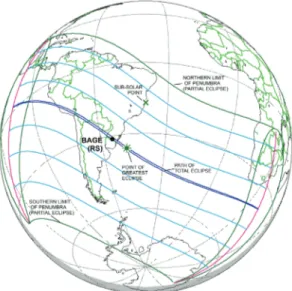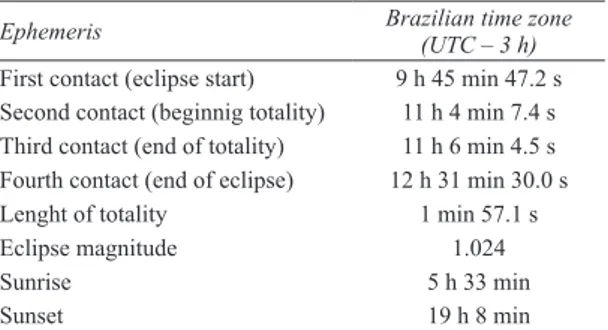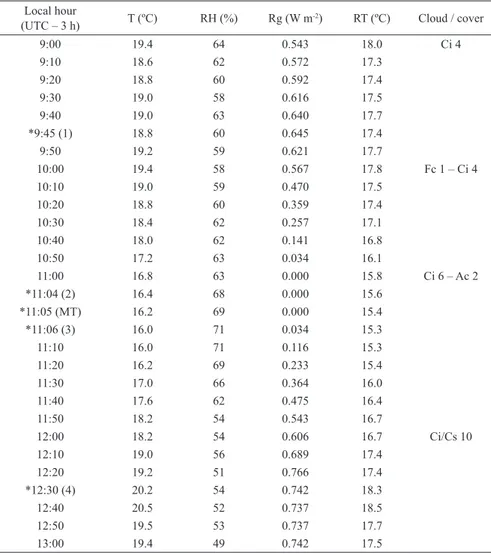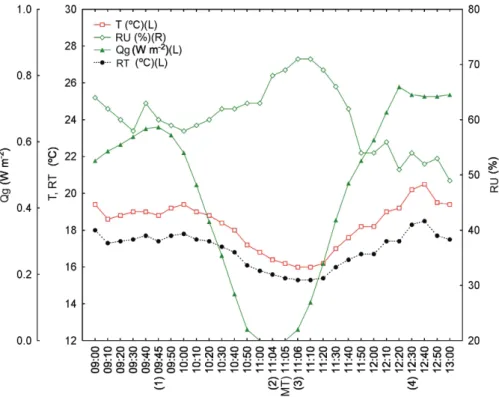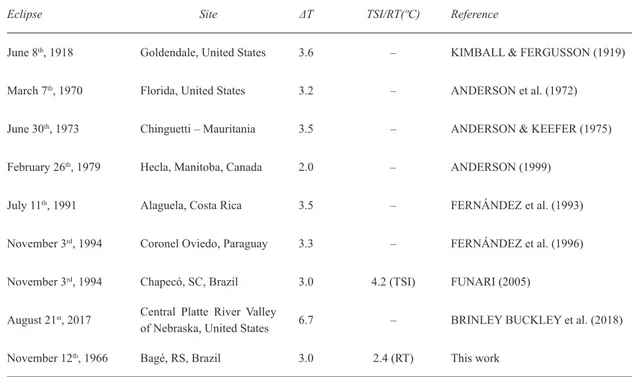EFFECTS OF TOTAL ECLIPSE OF THE SUN IN NOVEMBER 12th, 1966 IN BAGÉ (RS), BRAZIL, ON THE METEOROLOGICAL PARAMETERS
Frederico Luiz FUNARI Paulo MARQUES DOS SANTOS ABSTRACT
This work presents the evaluation of the thermal sensitivity index and global radiation during the total eclipse of the sun on November 12th, 1966, in the city of Bagé, RS, Brazil, located in the central line of the totality range of the eclipse. Temperature (ºC), relative air humidity (%), cloudiness and wind speed were acquired in the international airport of the city for the calculation of the resultant temperature index by using Missenard’s method (1948). Global radiation data was obtained from Eppley spectral radiometer. The results showed a variation in thermal sensation, due to the decreased global radiation and corresponding decreased temperature and increased relative humidity during the eclipse.
Keywords: Thermal sensation; Resultant temperature; Total solar eclipse; Temperature; Relative humidity; Global radiation; Bagé; Brazil.
RESUMO
O ECLIPSE TOTAL DO SOL OCORRIDO EM 12 DE NOVEMBRO DE 1966 EM BAGÉ (RS), BRASIL, E SEUS EFEITOS NOS PARÂMETROS METEOROLÓ-GICOS. O presente trabalho apresenta o comportamento do índice de sensação térmica e da radiação global durante o eclipse total do Sol em 12 de novembro de 1966, na cida-de cida-de Bagé (RS), Brasil, localizada ao longo da faixa cida-de totalidacida-de do eclipse. Medidas de temperatura (ºC), umidade relativa do ar (%), nebulosidade e velocidade do vento foram realizadas no aeroporto internacional da cidade para o cálculo da temperatura re-sultante, conforme o método de Missenard (1948). Dados sobre a radiação global foram obtidos com o radiômetro espectral Eppley. Os resultados mostraram uma variação da sensação térmica devido ao decréscimo da radiação global e consequente decréscimo da temperatura e aumento da umidade relativa do ar durante o eclipse.
Palavras-chave: Sensação térmica; Temperatura resultante; Eclipse total do Sol; Tem-peratura; Umidade relativa do ar; Radiação global; Bagé; Brasil.
1 INTRODUCTION
In astronomy, eclipse refers to the partial or total obscuration of a celestial body due to the interposition of another. When a new moon is in perfect alignment with the Earth and the sun, it projects a cone of shadow that can reach regions of the terrestrial surface, completely or partially eclipsing the sun. Therefore, there will be an eclipse of sun over these regions. The fact that
the sun and the moon present almost the same apparent diameter (about half a degree), and being the eclipse of the sun caused by the projection of lunar shadow on Earth, this phenomenon is impossible to be seen at the same time from all points of the globe.
Due to the centering of the axis of the cone-like shadow, the solar eclipse can be partial, total, or even annular – i.e., when the lunar diameter is
inferior to the one of the sun at that moment. A total solar eclipse can last up to 7 minutes during its peak (total darkening).
The occurrence of a total solar eclipse is a relatively rare phenomenon due to the moon and Earth movements in their orbit and inclinations. Despite the wide extension of the Brazilian territory, the occurrence of this phenomenon is quite rare, governed by the Saros period, with cyclicity of 18 years and 11 days. However, there are deviations due to the Earth–moon distance and the revolution of the moon around the Earth in an elliptical orbit.
Observing a total solar eclipse for science is a fundamental condition for getting to know it as a star that provides us with energy. For solar physics, it is important for studies of the solar corona (outer region of the sun where temperature reaches one million degrees), which is only possible during a total solar eclipse. Another fact is the so-called “Einstein Effect”, which consists of the deviation of the visible rays of stars during the totality of the phenomenon, proving Einstein’s theory of relativity by means of the deviation of light by a gravitational field. HARRISON & HANA (2016) cite several meteorological observations that can be performed during total eclipses of the sun.
Another important fact is its effect on living things. During the whole eclipse, birds “gather to sleep” and, in some cases, even die of fright — fact described by Riccioli in 1560 on the eclipse of the 7th of June of 1415 in Bohemia (FLAMMARION 1937). Besides that, bats fly as if it were night, and load animals and cattle sleep. Humans feel a cold sensation due to the gradual fall of solar radiation and consequent decreased temperature and increased relative humidity. In addition, people feel fear and joy after the completion of the totality of the eclipse (FLAMMARION 1937, BEDAQUE & TRAVNIK 1992, FUNARI 2005).
Although few papers have dealt with the thermal sensation during an eclipse phenomenon, an experiment addressing such features was carried out in Chapecó (SC), Brazil, during the total eclipse of the sun in November 3rd, 1994 (FUNARI 2005).
The objective of the present study was to evaluate the modifications on air temperature (ºC), relative humidity (%), global radiation (W m-2), wind (m s-1) and cloud cover (tenths of covered sky) during the total eclipse of the sun in November 12th, 1966 in Bagé (RS), Brazil. From
these meteorological parameters, the resultant temperature (RT) was calculated using the MISSENARD equation (1948).
2 ECLIPSE PARAMETERS
The total solar eclipse in November 12th, 1966 had a total range of 40 to 85 km wide, beginning in the Pacific Ocean, crossing the South American continent from Lima (Peru) to the extreme south of Brazil, following the Atlantic Ocean to completion in southern Africa. It was verified that the part of the totality band that passed through Brazil was in the south of the state of Rio Grande do Sul (Figure 1). On November 12th, 1966, the angular diameter of the moon was 32’32”, and the sun’s was 32’19”, resulting in a difference of 13” between these diameters. At its totality band in Brazil, the entire eclipse would last from 1’51” to 1’57”, with the sun at 65 to 70° above the horizon. The ephemeris and eclipse phases were recorded at Brazilian time zone (UTC - 3 h) (Table 1).
3 MATERIAL AND METHODS
Bagé (Rio Grande do Sul state, south of Brazil), located at the eclipse’s center of range during its totality, was chosen for the
FIGURE 1 – The map depicts the geographic regions
of the eclipse visibility – November 12th, 1966
(Sour-ce: available at: <http://www.eclipsewise.com/solar>.
Fred Espenak. Accessed on: September 12th, 2018).
The total eclipse could be observed in Peru, Chile, Bolivia, Argentina, Uruguay, and Brazil.
meteorological observations. Other Brazilian and international institutions had also chosen this city, located at 200 m of altitude, 200 km distant from the Atlantic Ocean, at the coordinates: latitude 31°19’51” S, longitude 54°06’25” W. It is located in a region known as gaúcho campaign, with low hills covered predominantly by natural grasslands (pampas) and subordinately by Araucaria angustifolia forest. Since that period, wheat and livestock farming are the predominant land use in this region.
According to Köeppen, the climate is classified as Cfa (subtropical). Bagé has an annual mean temperature of 23.8°C, average annual global radiation of 181.4 W m-2, average precipitation of 1,367.4 mm, average annual relative humidity at 73%, and the predominant wind is to the eastern direction. It has two well defined seasons (cold and hot), with similar or even higher temperatures than tropical regions, which favor the formation of rain clouds. Precipitations are generated by the interaction between Polar Atlantic and Tropical Continental air masses.
The meteorological observations on the day of the eclipse were obtained by Paulo Marques dos Santos and Rogério Carvalho de Godoy in a reserved place in the Bagé Airport area, located at: 31°22’S and 54°07’W, at an altitude of 181.32 m.
Air temperature (°C) and relative humidity (%) parameters were acquired every 10 minutes from 9 to 13 h ST using an Assmann-Fuess electrical aspiration psychrometer. At the same intervals, global radiation data were obtained using a radiometer Eppley model 15, and recorded in a Bristol’s potentiograph. The values were corrected by the manufacturer’s constant (K = reading * 0.4). It should be noted that the instruments available at that time did not have the same technology as current digital ones. However, this did not invalidate the data, since
the instruments have great precision and some of them are still in use.
The cloudiness and general conditions of the weather were assessed during psychrometric observation hours. Observations during the course of the eclipse were complemented by those obtained from the Brazilian Air Force: the direction and speed of the wind and height of the clouds. Horizontal visibility was 20 km through the eclipse.
For the calculation of the RT, the equation of MISSENARD (1948) was used (Equation 1); it is the most indicated one and does not require the inclusion of wind. RT = T - 0.4 (T - 10) (1 - 0.01* UR) (Eq. 1) Where: RT = resultant temperature (°C); T = air temperature (°C); UR = relative humidity (%).
Equation 1 allows to calculate the RT, which can be used to evaluate the thermal sensation (comfort/discomfort) index for humans. The RT can be calculated without the influence of wind, whose speed during the course of the eclipse was an average of 2.6 m s-1 (9.4 km h-1), considered
light breeze on the Beaufort scale. In this case, the wind did not influence the RT, since speed becomes significant at 3.0 m s-1. RT values are very similar to the thermal sensitivity index (TSI) ones (FUNARI 2006), when the influence of the wind is negligible. RT values were compared to the thermal sensation classes (Table 2) established by FUNARI (2006).
4 RESULTS AND DISCUSSION
During the eclipse, there was a decrease in air temperature, with consequent increase of the relative humidity. It resulted from the reduced direct radiation flux caused by the eclipse (Table 3, Figure 2).
The decrease of the temperature (3.0°C) was not higher due to the presence of cirrus clouds at the totality and also of altocumulus and fractocumulus during the entire period of the eclipse, taking up 6/10 of sky.
Relative humidity increased by 8% during the eclipse. The decrease in the RT was 2.4°C, resulting from the RT difference of 9h40 ST (17.7°C) – before the eclipse – and 11h06 ST (15.3°C) at the end of its totality. This reduction
Ephemeris Brazilian time zone(UTC – 3 h) First contact (eclipse start) 9 h 45 min 47.2 s Second contact (beginnig totality) 11 h 4 min 7.4 s Third contact (end of totality) 11 h 6 min 4.5 s Fourth contact (end of eclipse) 12 h 31 min 30.0 s
Lenght of totality 1 min 57.1 s
Eclipse magnitude 1.024
Sunrise 5 h 33 min
Sunset 19 h 8 min
TABLE 1 – Ephemeris: schedule at Bagé (RS), Brazil (IAG, 1965).
Class TSI (Celsius) Thermal sensation Physiological Response
1 < 6.0 Very high cooling Very strong thrill
2 6.1 to 8.9 High pressure cooling Strong thrill
3 9.0 to 11.9 Cold Thrill
4 12.0 to 14.9 Discomfort from cold Vasoconstriction
5 15.0 to 17.9 Light discomfort cold Slight cooling
6 18.0 to 20.9 Lower limit zone Thermal comfort
7 21.0 to 23.9 Center comfort zone Thermal comfort
8 24.0 to 26.9 Upper comfort zone Thermal comfort
9 27.0 to 29.9 Light discomfort heat Weak transpiration / Vasodilatation
10 30.0 to 32.9 Heat discomfort Intense transpiration
11 > 33.0 Hight discomfort from heat Regulatory problems
TABLE 2 – Thermal sensation classes and their physiological responses.
Source: based on FUNARI (2006).
Local hour
(UTC – 3 h) T (ºC) RH (%) Rg (W m-2) RT (ºC) Cloud / cover
9:00 19.4 64 0.543 18.0 Ci 4 9:10 18.6 62 0.572 17.3 9:20 18.8 60 0.592 17.4 9:30 19.0 58 0.616 17.5 9:40 19.0 63 0.640 17.7 *9:45 (1) 18.8 60 0.645 17.4 9:50 19.2 59 0.621 17.7 10:00 19.4 58 0.567 17.8 Fc 1 – Ci 4 10:10 19.0 59 0.470 17.5 10:20 18.8 60 0.359 17.4 10:30 18.4 62 0.257 17.1 10:40 18.0 62 0.141 16.8 10:50 17.2 63 0.034 16.1 11:00 16.8 63 0.000 15.8 Ci 6 – Ac 2 *11:04 (2) 16.4 68 0.000 15.6 *11:05 (MT) 16.2 69 0.000 15.4 *11:06 (3) 16.0 71 0.034 15.3 11:10 16.0 71 0.116 15.3 11:20 16.2 69 0.233 15.4 11:30 17.0 66 0.364 16.0 11:40 17.6 62 0.475 16.4 11:50 18.2 54 0.543 16.7 12:00 18.2 54 0.606 16.7 Ci/Cs 10 12:10 19.0 56 0.689 17.4 12:20 19.2 51 0.766 17.4 *12:30 (4) 20.2 54 0.742 18.3 12:40 20.5 52 0.737 18.5 12:50 19.5 53 0.737 17.7 13:00 19.4 49 0.742 17.5
TABLE 3 – Meteorological parameters during the solar eclipse in Bagé, RS, Brazil: temperature (T), relativity humidity (RH), global radiation (Rg), resultant temperature (RT) and cloud cover.
* (1): First contact; (2): second contact — beginning of totality; (MT): maximum of totality; (3): end of totality; (4): end of eclipse.
in the RT was described by observers as a mild cold sensation, physiological response of slight cooling (class 5 of Table 2).
Table 3 and figure 2 show the effects of the eclipse on the meteorological parameters – global radiation reaching 0.0 W m-2 due to the total hiding of the solar disk by the lunar one (magnitude = 1.024 lunar disk). The total of radiation recorded on the day of eclipse was 309.6 W m-2. In the following day (November 13th, 1966), with similar meteorological characteristics, the total radiation was of 325.3 W m-2. On November 14th, 1966, when the sky presented a few clouds, global solar radiation totalized 361.0 W m-2. Thus, the eclipse observed in Bagé promoted an approximate reduction of 4.8% of the total daily global radiation.
The decrease in air temperature (°C) and consequent increase in relative humidity (%), which influenced the RT, are shown in table 3 and figure 2.
Table 4 illustrates the decrease of air temperature and RT/TSI during other total solar eclipses around the world. The decrease of temperature (ΔT) in Bagé was similar than the ones measured in other parts of the world (2.0 - 6.7°C). The total eclipses of 1966 (Bagé) and 1994 (Chapecó) had different durations of totality
– the former had the duration of 117 seconds and the latter 230 seconds. There was slight cloudiness (cirrus and altocumulus) in Bagé, whereas the sky remained clear in Chapecó; these factors could have possibly influenced RT/TSI values.
5 CONCLUSIONS
The following conclusions can be drawn based on the meteorological observations of the total eclipse of the sun in Bagé on November 12th, 1966:
• There was a decrease in air temperature and an increase in relative humidity due to the reduction of global radiation values during total eclipse. These values were not higher due to the presence of clouds of the cirrus genus during the totality;
• The reduction of air temperature during the eclipse was 3.0°C, and the relative humidity increased 8%;
• The decrease in RT was 2.4°C, which caused a slight cold sensation according to the thermal sensation classes established by FUNARI (2006);
• The weather type of the days after the so-lar eclipse shows simiso-larity with the day of the
FIGURE 2 – Meteorological parameters during the day of the eclipse: temperature (T), relative humidity (RH), global solar radiation (Qg), resultant temperature (RT); MT: maximum of totality.
eclipse (November, 12th). However, the amount of global radiation on the day of the eclipse was inferior than the subsequent days.
6 ACKNOWLEDGMENTS
We thank the two reviewers of Revista do Instituto Geológico for their helpful comments, and Letícia F. Xavier for the revision of the text.
7 REFERENCES
ANDERSON, J. 1999. Meteorological changes during a solar eclipse. Weather, 54(7): 207-215.
ANDERSON, R.C.; KEEFER, D.R. 1975. Observation of the temperature and pressure changes during the 30 June 1973 solar eclipse. Journal of the Atmospheric Sciences, 32: 228-231. https://doi.org/10.1175/1520-0469(1975)032%3C0228:OOTTAP%3E2.0. CO;2
ANDERSON, R.C.; KEEFER, D.R.; MYERS, O.E. 1972. Atmospheric pressure and temperature changes during 7 march 1970 solar eclipse. Journal of the Atmospheric Sciences, 29: 583-587.
https://doi.org/10.1175/1520-0469(1972)029%3C0583:APATCD%3E2.0. CO;2
BEDAQUE, P.; TRAVNIK, N.A.S. 1992. Eclipse total of Sun in Tefé-AM on July 11, 1991. (personal communication).
BRINLEY BUCKLEY, E.M.; CAVEN, A.J.; GOTTESMAN, B.L.; HARNER, M.J.; PIJANOWSKY, B.C.; FORSBERG, M.L. 2018. Assessing biological and environmental effects of a total solar eclipse with passive multimodal technologies. Ecological Indicators, 95(1): 353-369. http:// dx.doi.org/10.1016/j.ecolind.2018.07.017 FERNÁNDEZ, W.; CASTRO, V.; HIDALGO, H.
1993. Air temperature and wind changes in Costa Rica during the total solar eclipse of July 11, 1991. Earth, Moon, and Planets, 63(2): 133-147. https://doi.org/10.1007/ BF00575102
FERNÁNDEZ, W.; HIDALGO, H.: CORONEL, G.; MORALES, E. 1996. Changes in meteorological variables in Coronel Oviedo, Paraguay, during the total solar eclipse of 3 November 1994. Earth Moon and
Eclipse Site ΔT TSI/RT(ºC) Reference
June 8th, 1918 Goldendale, United States 3.6 – KIMBALL & FERGUSSON (1919)
March 7th, 1970 Florida, United States 3.2 – ANDERSON et al. (1972)
June 30th, 1973 Chinguetti – Mauritania 3.5 – ANDERSON & KEEFER (1975)
February 26th, 1979 Hecla, Manitoba, Canada 2.0 – ANDERSON (1999)
July 11th, 1991 Alaguela, Costa Rica 3.5 – FERNÁNDEZ et al. (1993)
November 3rd, 1994 Coronel Oviedo, Paraguay 3.3 – FERNÁNDEZ et al. (1996)
November 3rd, 1994 Chapecó, SC, Brazil 3.0 4.2 (TSI) FUNARI (2005)
August 21st, 2017 Central Platte River Valley
of Nebraska, United States 6.7 – BRINLEY BUCKLEY et al. (2018)
November 12th, 1966 Bagé, RS, Brazil 3.0 2.4 (RT) This work
TABLE 4 – Data of air temperature and thermal sensitivity index (TSI), during other solar eclipses.
Planets, 74(1): 49-59. https://doi.org/10.1007/ BF00118721
FLAMMARION, C. 1937. As maravilhas celestes. Educação Nacional, Lisboa, 452 p.
FUNARI, F.L. 2005. Variação do índice de conforto térmico humano em Chapecó-SC (Brasil), durante o eclipse total do Sol de 3-11-1994. In: FFLCH-USP, SIMPÓSIO BRASILEIRO DE GEOGRAFIA FÍSICA APLICADA, 11, Anais, v.1, p.1793-1796.
FUNARI, F.L. 2006. O Índice de Sensação Térmica Humana em função dos tipos de tempo na Região Metropolitana de São Paulo. Faculdade de Filosofia, Letras e Ciências Humanas, Universidade de São Paulo, São Paulo, PhD Thesis, 114 p.
HARRISON, R.G.; HANNA, E. 2016. The solar eclipse: a natural meteorological experiment.
Philosophical Transactions Royal Society A, 374(2077): 20150225. http://dx.doi. org/10.1098/rsta.2015.0225
INSTITUTO DE ASTRONOMIA, GEOFÍSICA E CIÊNCIAS ATMOSFÉRICAS DA UNIVERSIDADE DE SÃO PAULO (IAG/USP). 1965. Apêndice do Anuário do Observatório de São Paulo para 1966. Coordenação do Dr. Alexandre Postoiev. Universidade de São Paulo, São Paulo, 4 p. KIMBALL, H.H.; FERGUSSON, S.P. 1919. Influence
of the solar eclipse of June 8, 1918, upon radiation and other meteorological elements. Monthly Weather Review, 47: 5-16. https://doi. org/10.1175/1520-0493(1919)47%3C5:IOTSE O%3E2.0.CO;2
MISSENARD, H. 1948. Equivalence thermique dês ambiance. Chaleur et Industrie, 24: 159-183.
Author’s address:
Frederico Luiz Funari and Paulo Marques dos Santos – Laboratório de Hidrometeorologia, Instituto de Astronomia, Geofísica e Ciências Atmosféricas, Universidade de São Paulo – Avenida Miguel Stéfano, 4200, Água Funda, CEP: 04301-904, São Paulo, SP, Brasil. E-mail: ffunari@uol.com.br
